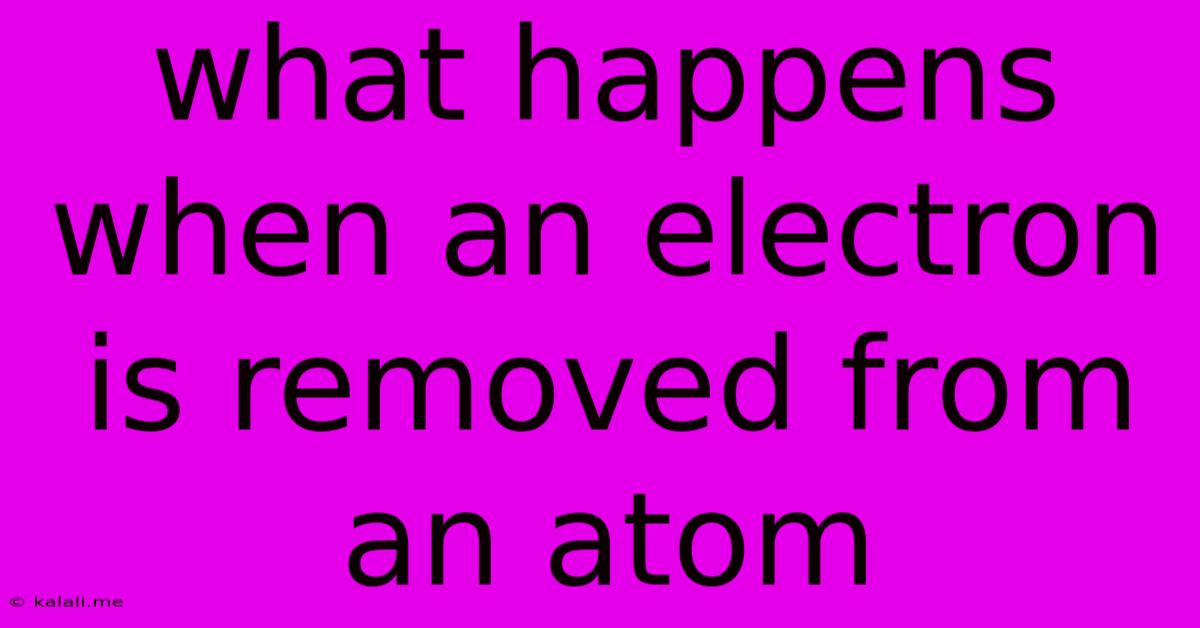What Happens When An Electron Is Removed From An Atom
Kalali
Jun 14, 2025 · 3 min read

Table of Contents
What Happens When an Electron is Removed from an Atom? Ionization and its Consequences
When an electron is removed from an atom, a fundamental change occurs, transforming the atom's properties and behavior. This process, known as ionization, has far-reaching consequences in various fields, from chemistry and physics to materials science and astrophysics. This article will explore the effects of electron removal, discussing the resulting ion, its charge, and the changes in its chemical and physical properties.
Understanding Ionization: A fundamental process
Atoms, in their neutral state, possess an equal number of protons (positively charged particles in the nucleus) and electrons (negatively charged particles orbiting the nucleus). The removal of an electron disrupts this balance, leaving behind a positively charged ion. The energy required to remove an electron is called the ionization energy, and this energy varies depending on the atom's atomic structure and the specific electron being removed. Electrons closer to the nucleus experience a stronger attractive force and thus require more energy to be removed compared to those further away.
The Formation of Ions: Positive and Negative
The loss of an electron creates a cation, a positively charged ion. The magnitude of the positive charge depends on the number of electrons removed. For example, removing one electron from a neutral sodium atom (Na) forms a sodium cation (Na⁺), while removing two electrons would create Na²⁺. Conversely, gaining an electron creates an anion, a negatively charged ion. While this article focuses on electron removal, understanding the dual nature of ion formation is crucial.
Changes in Chemical Properties: Reactivity and Bonding
The removal of an electron significantly alters an atom's chemical properties. Cations are generally more reactive than their neutral counterparts because they have an incomplete electron shell, making them eager to participate in chemical bonding to achieve a more stable electron configuration. This often involves ionic bonding, where cations attract negatively charged anions to form stable ionic compounds. The chemical reactivity of an ion is also heavily influenced by its charge and ionic radius. Higher charges and smaller radii generally lead to increased reactivity.
Changes in Physical Properties: Size and Spectral Lines
Ionization also affects the physical properties of an atom. The removal of an electron leads to a decrease in the atom's size, as the remaining electrons are more strongly attracted to the nucleus. Additionally, the removal of electrons changes the atom's electronic configuration, altering its interaction with electromagnetic radiation. This results in changes to the atom's emission and absorption spectra, which are valuable tools for identifying elements and studying their properties. Observing spectral lines is a key method in astronomy for determining the composition of stars and other celestial bodies.
Applications of Ionization:
The process of ionization is crucial in many applications, including:
- Mass Spectrometry: Used to identify and quantify different molecules based on their mass-to-charge ratio. Ionization is the initial step in this technique.
- Plasma Physics: Plasmas are ionized gases, crucial in various technologies, including fusion energy research, plasma displays, and semiconductor manufacturing.
- Radiation Detection: Ionizing radiation, such as X-rays and gamma rays, causes ionization in materials, enabling detection via ionization chambers or Geiger counters.
- Flame Spectroscopy: The characteristic colors of flames are due to the ionization and excitation of metal atoms in the flame.
Conclusion:
The removal of an electron from an atom, the process of ionization, fundamentally alters its properties and behavior. Understanding this process is crucial in various scientific disciplines, paving the way for advances in technology and our comprehension of the universe. From the formation of ionic compounds to the detection of ionizing radiation, ionization plays a pivotal role in a vast array of applications.
Latest Posts
Latest Posts
-
Which Of The Following Is True Regarding Blood Vessels
Jun 15, 2025
-
Which Of The Following Are Not Normally Found In Urine
Jun 15, 2025
-
What Is The Opposite Of Arrogance
Jun 15, 2025
-
How Many Drops Per Minute Is 500 Ml Per Hour
Jun 15, 2025
-
Least Common Multiple Of 11 And 10
Jun 15, 2025
Related Post
Thank you for visiting our website which covers about What Happens When An Electron Is Removed From An Atom . We hope the information provided has been useful to you. Feel free to contact us if you have any questions or need further assistance. See you next time and don't miss to bookmark.